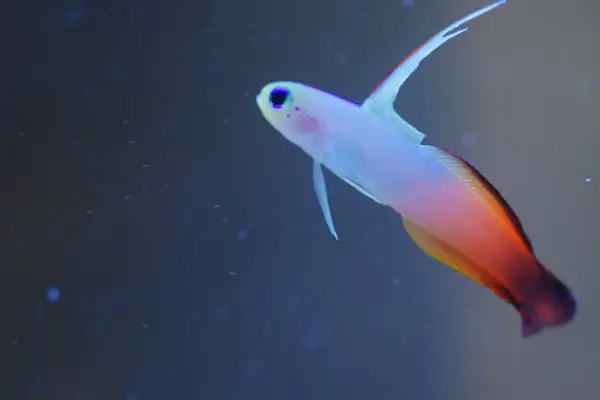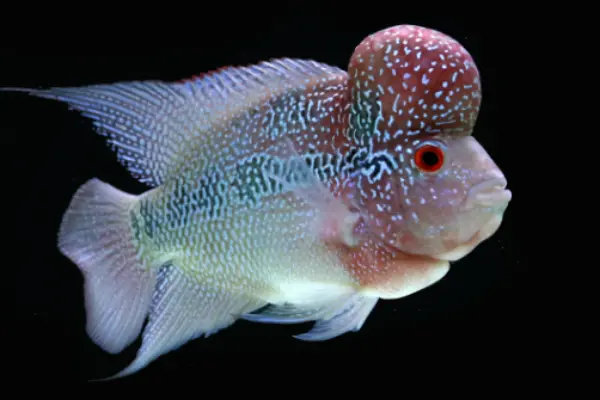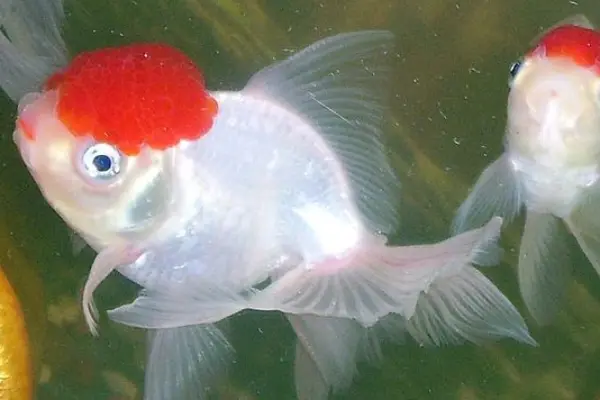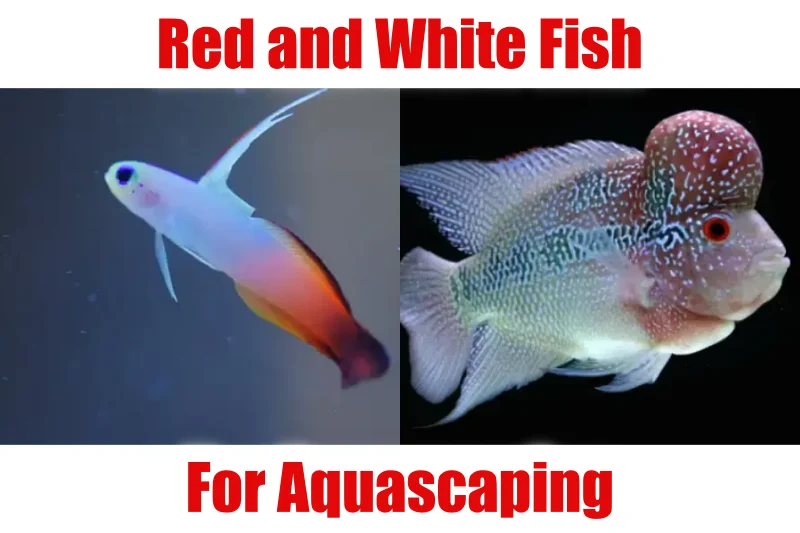Most of the earth is covered with water. Similarly, aquatic animal populations outnumber humans and other land creatures. The beautiful blue water has the most colorful creatures. Have you ever seen a red and white fish or heard about any red and white fish? Today, we are going to look at the 13 most beautiful red and white fish.
Here we go,
13 Best Red And White Fish
1. Red Firefish

| Scientific name | Nemateleotris magnifica |
| Diet | meaty foods, including mysis shrimp, brine shrimp, finely chopped fresh or frozen seafood, and vitamin-enriched prepared foods |
| Size | ~9 cm |
| Location | India, Africa, and Hawaii |
The Firefish Goby, also known as the Firefish Goby, Fire Goby, and Magnificent or Fire Dartfish, is a stunning fish with a unique body shape and personality.
It is native to the Indian and Pacific oceans, where it lives in coral reefs at depths of 6 to 70 meters. The firefish goby is docile and timid, with a bright yellow head, white body, and red-orange tail.
It has black highlighted dorsal fins. The fish flicks them back and forth as a signal to conspecifics. Adults can reach a maximum length of 9 cm and live in groups. The diet should consist of vitamin-enriched brine fish, mysis shrimp, and prepared marine foods.
2. Coral Red Dwarf Pencil Fish
| Scientific name | Nannostomus mortenthaleri |
| Diet | Tiny invertebrates and other zooplankton |
| Size | ~1 inch (2.9 cm) |
| Location | Venezuela, Peru, Guyana, Suriname, and Colombia |
This species of red and white fish has the scientific name Nannostomus mortenthaleri. The Coral Red Pencilfish, also known as the Red Arc Pencilfish, Peruvian Red Pencilfish, or Ruby Red Pencilfish, has an elongated body pointed at the snout and an expected lifespan of 5 years.
Its red body features two strong horizontal black lines, giving it a broadly striped appearance. The lower portion is paler and often white.
The males are brighter-colored than the females. This red and white fish is commonly found in Brazil, Columbia, and Peru in South America. These are omnivorous fishes.
3. Flowerhorn fish

| Scientific name | Amphilophus hybrid |
| Diet | Earthworms, raw shrimp, strips of lean fish, squid, krill, and insects |
| Size | 25-40 cm |
| Location | Malaysia, Thailand, and Taiwan |
Flowerhorns have a remarkable growth rate, reaching up to 2 cm in a month during their first year of life. However, this growth rate can vary depending on the individual fish and their care.
The Red Dragon Flower Horn is the most common and recognizable, with a bright red coloration as it matures. The hump on the forehead, a distinctive feature of flower horns, is a common breeding parameter.
The average lifespan of flowerhorns is 8 to 12 years, with proper care potentially longer. The hump is a unique feature of flower horns, with both male and female species having small, unpronounced humps.
Red Dragon Flower Horn, recognizable as silver with dark spots matures to a bright red with a marbled pattern and white and black patches.
4. Skunk Tile Goby
| Scientific name | Hoplolatilus marcosi |
| Diet | Amphipods, copepods, tiny crustaceans, various larvae, and other zooplankton |
| Size | 12-15 cm |
| Location | India, Pacific Ocean |
Skunk tilefish is a social fish found in small groups in the Indo-Pacific. Also known as Red Stripe tilefish. They hunt zooplankton in rock rubble and substrate near coral reef structures.
These white, bright orange-to-red lateral stripe fish like to live in pairs. They have an elongated body with a striking red line.
Their body, fins, and eyes have a slight blue tint, adding to their appeal. This peaceful fish is a beautiful addition to any community aquarium.
5. White Red Cap Goldfish

| Scientific name | Carassius auratus |
| Diet | brine shrimp, blood worms, Daphnia, or tubifex worms |
| Size | 20-30 cm |
| Location | China, Japan |
Red-cap Oranda goldfish are a fancy breed with a double tail fin that flows beautifully as they swim. They have egg- or ball-shaped bodies that are almost as tall and wide as they are long.
Most Red Cap Orandas have red, orange, yellow, or white bodies, with the body color ranging from bicolor to tricolor varieties. Young Red Cap Orandas lack a wen, a fleshy growth on the head like a cap, which develops into an eye-catching red or orange color as they age.
The oranda is a metallic or matte-scaled goldfish with a large, long, and deep body accompanied by a long quadruple tail.
They are available in various colors, such as orange, red, red-and-white, red-and-black, black, blue, chocolate, bronze, white, or silver, black-and-white (panda-colored), red-black-and-white (tricolor), and calico.
6. Red Striped Goby
| Scientific name | Trimma cana |
| Diet | brine shrimp, and mysis shrimp |
| Size | ~2.5 cm |
| Location | Philippines, Palau |
The Red Striped Gody, also known as the Candycane Pygmy Goby, lives in the western Pacific Ocean on hard coral reefs.
Males grow up to 1 inch long and have unique features like a white body with eight vertical red bars, yellow spots on the middle fins, and a longer second spine in the dorsal fin.
They lack scales and have grooves between and behind their eyes. Found at depths between 39 and 115 feet.
7. Redbarred hawkfish
| Scientific name | Cirrhitops fasciatus |
| Diet | Philippine Sea, the Coral Sea, and Micronesia |
| Size | ~3.5 inches (9 centimeters) |
| Location | Hawaiian Islands, Japan |
The red barred hawkfish is an endemic species of fish found in the Hawaiian Islands, Madagascar, and the Mascerene Islands. It has a whitish background color with reddish or brown vertical bands on the flanks and back and speckling on the face.
It has 10 spines, soft rays in the dorsal fin, and moderate incisions on membranes between them. The roof of the mouth has small teeth, and the upper three-fifths of the preoperculum have large serrations.
The dorsal profile of the snout is convex, and the caudal fin is truncate.
8. Kohaku Koi Fish
| Scientific name | Cyprinus carpio |
| Diet | Fish eggs, juvenile, fish, and insects |
| Size | 60-120 cm |
| Location | Japan |
Koi fish, a classic species, have bright red markings on their bodies, which should be even across the body.
The fish has sharp edges near the head and tail. Koi fish have ghostly white fins at their sides, tails, and back and distinctive, googly-eyed eyes.
9. Redbar anthias
| Scientific name | Pseudanthias rubrizonatus |
| Diet | Small zooplankton, including copepods and amphipods |
| Size | ~12 cm |
| Location | Pacific Ocean |
Pseudanthias rubrizonatus is a marine ray-finned fish species found in the Indo-Pacific. Males are pinkish to pinkish orange at the anterior end of the body, bright yellow on the posterior and tail, separated by a red vertical bar.
The dorsal fin has a lilac margin, while the outer lobes of the caudal fin have red tips. Females are reddish-pink, paler ventrally, and have dark spots in their scales.
The dorsal fin contains 10 spines and 16 soft rays, while the anal fin has 3 spines and 7 soft rays. The maximum total length is 12 centimeters.
10. Persimmon Blood Parrot
| Scientific name | Amphilophus citrinellus x Paraneetroplus synspilus |
| Diet | Flake foods, pellets, frozen worms, bloodworms |
| Size | 20-30 cm |
| Location | Asia |
Blood parrot cichlids are peaceful community fish with shy natures, known for their bright orange body and translucent fins. They have large eyes, broad fins, and parrot-style beaks.
However, they have genetic deformities from hybrid breeding, such as large nuchal fins, a small mouth opening and closing improperly, and teeth obstructing eating.
This makes self-defense difficult, especially in tank environments with aggressive fish. Breeders may use unethical dyeing to obtain new colors, potentially shortening the fish’s lifespan.
11. Blacktip Grouper
| Scientific name | Epinephelus fasciatus |
| Diet | crustaceans and smaller fishes |
| Size | ~40 cm |
| Location |
Red Sea, South Africa, Japan, Korea, southern Queensland in Australia, and Lord Howe Island.
|
The blacktip grouper is a marine ray-finned fish species found in the tropical Indo-Pacific region. The dorsal fin contains 11 spines and 15-17 soft rays, while the anal fin has 3 spines and 8 soft rays.
The color ranges from pale greenish grey, red, scarlet, with faint dark bars on the caudal peduncle.
The outer membrane of the spiny part of the dorsal fin is black or dark red. The species can reach a maximum total length of 40 centimetres (16 in) and weighs 2.0 kilograms (4.4 lb).
12. Tomato clownfish
| Scientific name | Amphiprion frenatus |
| Diet | zooplankton, small aquatic crustaceans and algae |
| Size | ~14 cm |
| Location | Western Pacific, Japan, and Indonesia |
The tomato clownfish, also known as blackback anemonefish, fire clown, or red tomato clown, is a marine fish native to the Western Pacific waters from Japan to Indonesia.
It is bright orange-red with a distinctive black outline, with females mostly blackish on the sides.
Males are smaller and red overall, while juveniles are darker red with two or three white bars. They have 9-10 dorsal spines, 2 anal spines, and 16-18 dorsal and 13-15 anal soft rays.
13. Bicolor goatfish
| Scientific name | Amphiprion frenatus |
| Diet | invertebrates, small crustaceans, and worms |
| Size | ~30 cm |
| Location | western Pacific Ocean |
Parupeneus barberinoides, also known as the bicolor goatfish, is a species of goatfish native to the western Pacific Ocean.
Found in coral reefs, it can reach a length of 30 centimetres (12 in). It is a commercially important species and can be found in the aquarium trade.
Conclusion:
These are some of the most manifest red and white-colored fish species. But this is not it; still, there are a variety of fish and aquatic animals in the aquarium to discover. and we will be back with some more interesting facts about them until then. Stay tuned to HowItSee.
FAQs:
Q1: What are the most notable characteristics of the Red Firefish?
Ans: The Red Firefish, also known as the Fire Goby, has a unique body shape with a bright yellow head, white body, and a red-orange tail. It features black highlighted dorsal fins and flicks them as a signal to conspecifics.
Q2: Where is the Coral Red Dwarf Pencil Fish commonly found?
Ans: The Coral Red Dwarf Pencil Fish is commonly found in South American countries like Venezuela, Peru, Guyana, Suriname, and Colombia.
Q3: What is unique about Flowerhorn fish?
Ans: Flowerhorn fish have a distinctive hump on their forehead.
Q4: Where can Skunk Tile Goby be found?
Ans: Skunk Tile Goby, scientifically named Hoplolatilus marcosi, is found in the Indo-Pacific, particularly in India and the Pacific Ocean.
Q5: What makes the White Red Cap Goldfish unique?
Ans: The White Red Cap Goldfish is known for its double tail fin and distinctive red cap or wen on the head. They originate from China and Japan.
Q6: Describe the appearance and habitat of the Red Striped Goby.
Ans: The Red Striped Goby, scientifically known as Trimma cana, has a white body with eight vertical red bars, yellow spots on the middle fins, and a longer second spine in the dorsal fin. They are found in the Philippines and Palau.
Q7: What are the distinctive features of the Redbarred Hawkfish?
Ans: The Redbarred Hawkfish, scientifically named Cirrhitops fasciatus, has reddish-brown vertical bands on its flanks and back. It is found in the Hawaiian Islands and Japan.
Q8: What are the characteristics of the Kohaku Koi Fish?
Ans: The Kohaku Koi Fish has bright red color. It has a classic appearance with balanced red markings on a white background.
Q9: What distinguishes the Redbar Anthias?
Ans: The Redbar Anthias males have a pinkish-orange anterior end and a bright yellow posterior with a red vertical bar.
Q10: Describe the appearance and characteristics of the Persimmon Blood Parrot.
Ans: The Persimmon Blood Parrot, resulting from hybrid breeding, has a bright orange body, translucent fins, and a parrot-style beak.
Also Read:

As a content writer, I like to write about different niches. I have a curiosity about nature and animals. And like to learn about them. Through my writing, I like to share my experience and knowledge with you. I hope you are enjoying it too.
